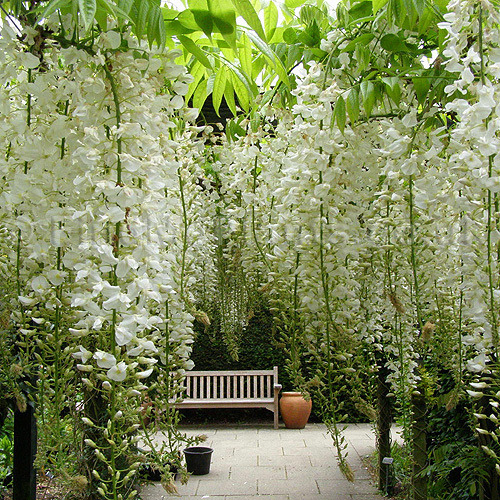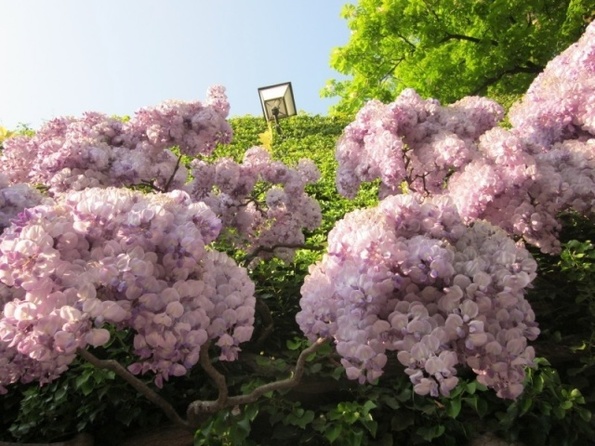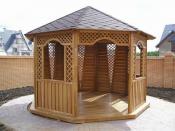Search
Login
Recommended
Ornamental and medicinal plants. Wisteria: planting, growing, pruning and care
Rightfully bearing the title of the victorious creeper, wisteria is considered one of the great climbing plants that do not lose their decorative qualities even in the autumn period. It was during this seasonal period that Queen Wisteria single-handedly occupied an honestly conquered throne in a practically frozen landscape kingdom, transforming her graceless plain corners, gates, arbors and trunks of dead trees.
Content
- The spectacular Queen Wisteria. Varieties
- All about the propagation of wisteria
- Planting Wisteria. Decorative solutions video
- Growing Wisteria. Care Features
- Pruning is a must
The spectacular Queen Wisteria. Varieties
Wisteria belongs to the genus of large tree-like lianas from the legume family, growing in the subtropical zone.

The genus Wisteria or, in other words, Wisteria has nine species, of which the Chinese wisteria and the Wisteria abundantly blooming, which are able to impress the eye with their spectacular outlines, are recognized as the most significant in the field of landscape design.

Fragrant flowers of lilac, blue with blue splashes, and sometimes white shades, collected in dense inflorescences reaching 30 centimeters long and complemented by an elegant frame in the form of unpaired cirrus leaves, densely cover the drooping branches-lianas that gracefully border the arbors, terraces and pergolas, hanging down freely.

As expected, the thermophilic representative of the subtropical flora of Wisteria is quite demanding on climatic conditions. A lover of plentiful illumination of warm winters, wisteria grows only in ecologically clean places and only in some cases is able to withstand a short-term decrease in temperature to 20 degrees below zero.

After reading all of the above, you probably wondered: How to grow wisteria ?, to which you can get an answer by reading the materials in this article.

All about the propagation of wisteria
Firstly, in order to grow a royal vine on a personal plot, you need to know all the details about the propagation of wisteria. According to experts, it is easiest to propagate a representative of the subtropics by cuttings.

The most optimal period for this is considered to be late autumn, when it is necessary to cut the vine from the bush with its subsequent cutting into cuttings, which are placed in order to be stored in a moistened substrate in a dark basement. With the onset of spring, cuttings are planted in open ground and covered with plastic bottles.

Wisteria can be propagated by winter vaccinations, which are done on the root system in connection with the friability of wood. Also, a method of propagation by horizontal layers is quite effective, the essence of which is the autumn cutting of shoots and pinning them to the ground. Top shoots are sprinkled with soil.

A common method of propagation of wisteria is considered to be propagation by winter cuttings. It got this name due to the fact that the optimal time for cuttings is late winter, when the prepared shoots are divided along the longitudinal axis with the subsequent cutting of each share into 5-centimeter cuttings with one bud in their middle part. The next step in this process is the rooting of cuttings in boxes with soil, which are left in greenhouses.

There are known cases of the propagation of wisteria by seeds, which can be sown in December in greenhouses or in the early spring in open ground. After sowing, germination may take up to two to three years. An advantage of this method is the early adaptation of seedlings to the surrounding weather conditions. Wisteria seedlings from the first days of germination become more hardy and resistant to lower temperatures, which is considered the most favorable factor when planting wisteria in the middle lane. The disadvantage is the need for a three-month scarification, which consists in puncturing the seeds and placing them in a humid environment in order to enhance the penetration of moisture into the seed.

Planting Wisteria. Decorative solutions
Landing of wisteria is recommended to be carried out near supporting structures, the role of which is easily performed by reinforced concrete structures and stone houses.

This is necessary so that the overgrown trunks of wisteria, which can sometimes reach 10 15 centimeters in diameter, do not crush fruit trees and a weak hedge. For Chinese Wisteria, lattice roofs and arches are often equipped, and then the branches of Wisteria are twisted around counterclockwise, while the flowering brushes of Wisteria are plentifully blooming, which blooms two to three weeks later than Chinese Wisteria and blooms once a season in a clockwise direction.

Such a compositional solution allows you to create a long-flowering hedge, the primaries of which are alternately Chinese Wisteria with its spectacular light purple or white flowers, collected in massive inflorescences, and wisteria ample-blooming, captivating the eye with long tassels of blue-violet inflorescences.
Before landing, you must carefully choose a place that should be the warmest and most lighted. The soil for the favorable development of wisteria should be nutritious and well-drained, and should also have a slightly alkaline reaction. Before planting, pits are prepared, the parameters of which are within 60x50x60 centimeters. Given the exactingness of wisteria to the growing environment, the application of mineral fertilizers is an obligatory stage of planting and is carried out at the rate of 20 30 g per cubic meter of land.


Growing Wisteria. Care Features
The most difficult period for growing wisteria is the period of adaptation of seedlings. At this time, it is necessary to water the wisteria with a weak solution of potassium permanganate and feed it with fertilizers, alternating mineral and organic, making compost is welcome.

But, given the pedigree of Wisteria, one should not abuse nitrogen-containing fertilizers, as belonging to the Bean family determines the structural features of the root system on which nitrogen-fixing bacteria are located. It should also be noted that young seedlings should not be watered with a solution of potassium permanganate from above, since this procedure can contribute to a burn of fragile leaves. After planting, it is necessary to mulch the seedling above the level of the root neck, which will help protect the root system and the root neck from summer overheating and drying out. As a mulch, dry composted grass or peat is ideal.

Wisteria pruning is a must
The laying of flower buds occurs on the lateral branches, which are thinner and need careful preservation.

It consists in thinning the branches, which adequately ensures the rejuvenation of the plant. Pruning is a prerequisite for the proper cultivation of wisteria, as it is recognized as a guarantee of abundant flowering. Young flowers are formed on the new shoots of this year, and that is why it is necessary to cut last year's shoots no less than 30 centimeters at the end of the flowering period. The second pruning is done after the leaves fall, when it is necessary to cut off all the side branches, leaving from three to five buds.






